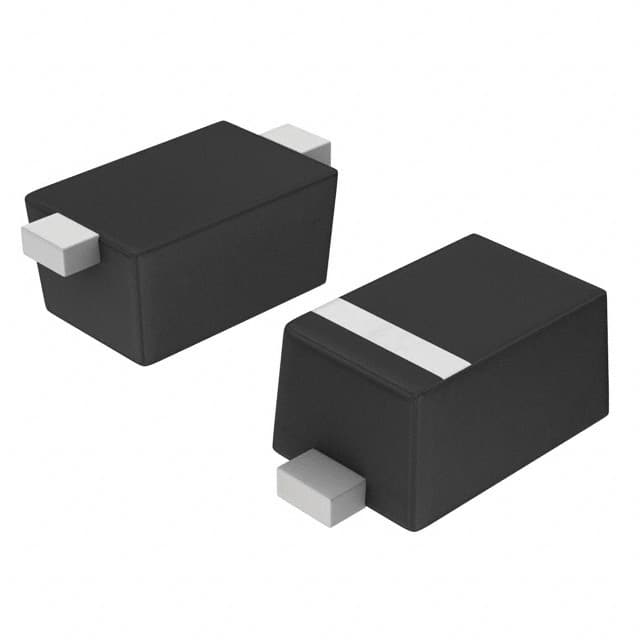Viz Specifikace pro podrobnosti o produktu.

MM5Z2V4ST1 Product Overview
Introduction
The MM5Z2V4ST1 is a semiconductor product belonging to the category of Zener diodes. This component is commonly used in electronic circuits for voltage regulation and protection against overvoltage conditions. The MM5Z2V4ST1 possesses specific characteristics, packaging, and quantity details that make it suitable for various applications.
Basic Information Overview
- Category: Zener Diode
- Use: Voltage regulation and overvoltage protection
- Characteristics: Precise voltage regulation, low leakage current, high reliability
- Package: SOD-523
- Essence: Semiconductor device for voltage regulation
- Packaging/Quantity: Available in tape and reel packaging with varying quantities
Specifications
The MM5Z2V4ST1 Zener diode has the following specifications: - Voltage: 2.4V - Power Dissipation: 200mW - Operating Temperature Range: -65°C to +150°C - Zener Impedance: 40Ω - Maximum Reverse Leakage Current: 100nA
Detailed Pin Configuration
The MM5Z2V4ST1 Zener diode features a standard SOD-523 package with two pins. The pin configuration is as follows: - Pin 1: Anode - Pin 2: Cathode
Functional Features
The key functional features of the MM5Z2V4ST1 Zener diode include: - Precise voltage regulation at 2.4V - Protection against overvoltage conditions - Low reverse leakage current - High reliability and stability in operation
Advantages and Disadvantages
Advantages
- Precise voltage regulation
- Compact SOD-523 package
- Low reverse leakage current
- Wide operating temperature range
Disadvantages
- Limited power dissipation capability
- Sensitive to excessive current and voltage spikes
Working Principles
The MM5Z2V4ST1 Zener diode operates based on the principle of the Zener effect, where it maintains a constant voltage drop across its terminals when operated in the reverse-biased mode. This allows it to regulate the voltage across a circuit and protect sensitive components from overvoltage conditions.
Detailed Application Field Plans
The MM5Z2V4ST1 Zener diode finds extensive application in various electronic circuits, including: - Voltage regulators in power supplies - Overvoltage protection in consumer electronics - Signal clamping and limiting circuits - Voltage reference circuits
Detailed and Complete Alternative Models
Some alternative models to the MM5Z2V4ST1 Zener diode include: - BZX84C2V4LT1G - MMBZ524BLT1G - PZM2.4NB2A
In summary, the MM5Z2V4ST1 Zener diode offers precise voltage regulation and overvoltage protection in a compact SOD-523 package, making it suitable for a wide range of electronic applications.
Word count: 410
Seznam 10 běžných otázek a odpovědí souvisejících s aplikací MM5Z2V4ST1 v technických řešeních
What is MM5Z2V4ST1?
- MM5Z2V4ST1 is a Zener diode with a voltage rating of 4.3V and a power rating of 200mW.
Where can MM5Z2V4ST1 be used in technical solutions?
- MM5Z2V4ST1 can be used in various technical solutions such as voltage regulation, overvoltage protection, and signal conditioning.
What is the maximum current that MM5Z2V4ST1 can handle?
- The maximum current for MM5Z2V4ST1 is typically around 50mA.
How does MM5Z2V4ST1 provide overvoltage protection?
- MM5Z2V4ST1 provides overvoltage protection by conducting excess voltage to ground once the voltage exceeds its rated value.
Can MM5Z2V4ST1 be used in reverse bias?
- Yes, MM5Z2V4ST1 can be used in reverse bias for applications such as voltage clamping.
What are the typical applications of MM5Z2V4ST1 in electronic circuits?
- MM5Z2V4ST1 is commonly used for voltage reference, voltage stabilization, and transient suppression in electronic circuits.
Is MM5Z2V4ST1 suitable for low-power applications?
- Yes, MM5Z2V4ST1 is suitable for low-power applications due to its 200mW power rating.
What is the temperature range for MM5Z2V4ST1?
- The operating temperature range for MM5Z2V4ST1 is typically -55°C to 150°C.
Does MM5Z2V4ST1 require any external components for operation?
- MM5Z2V4ST1 can be used independently but may require series resistors or capacitors for specific applications.
Are there any alternative components to MM5Z2V4ST1 with similar specifications?
- Yes, there are alternative Zener diodes with comparable voltage ratings and power ratings, such as BZX84C4V3 or MMSZ5240BT1G.

